Wallpaper typically has a lifespan of 10 to 15 years, influenced by the material and environmental conditions. Regular maintenance can prolong its durability, while factors like moisture and sunlight may lead to deterioration. Key indicators for replacement include visible damage, peeling, and fading, which should be addressed promptly to preserve the look and integrity of your space.

How long does wallpaper typically last?
Wallpaper generally lasts between 10 to 15 years, depending on the material and the conditions in which it is installed. Regular maintenance and care can extend its lifespan, while exposure to moisture and sunlight may shorten it.
Standard lifespan of vinyl wallpaper
Vinyl wallpaper is known for its durability and can last anywhere from 10 to 20 years. It is resistant to moisture and easy to clean, making it suitable for high-traffic areas like kitchens and bathrooms.
When properly maintained, vinyl wallpaper retains its color and texture over time. However, it may begin to show signs of wear, such as peeling or fading, especially in areas with direct sunlight.
Longevity of fabric wallpaper
Fabric wallpaper typically has a shorter lifespan, ranging from 5 to 15 years. While it offers a luxurious look and feel, it is more susceptible to damage from moisture and stains.
To prolong the life of fabric wallpaper, avoid placing it in humid environments and consider using a protective coating. Regular cleaning can help maintain its appearance, but be cautious with water-based cleaners.
Factors affecting wallpaper lifespan
Several factors influence the lifespan of wallpaper, including the type of material, installation quality, and environmental conditions. Proper installation is crucial; poorly applied wallpaper can peel or bubble more quickly.
Environmental factors such as humidity, temperature fluctuations, and exposure to sunlight can also impact durability. For instance, wallpaper in a bathroom may need replacement sooner due to moisture exposure.
Regular maintenance, such as cleaning and addressing any damage promptly, can help extend the life of your wallpaper. Consider checking for signs of wear every few years to determine if replacement is necessary.
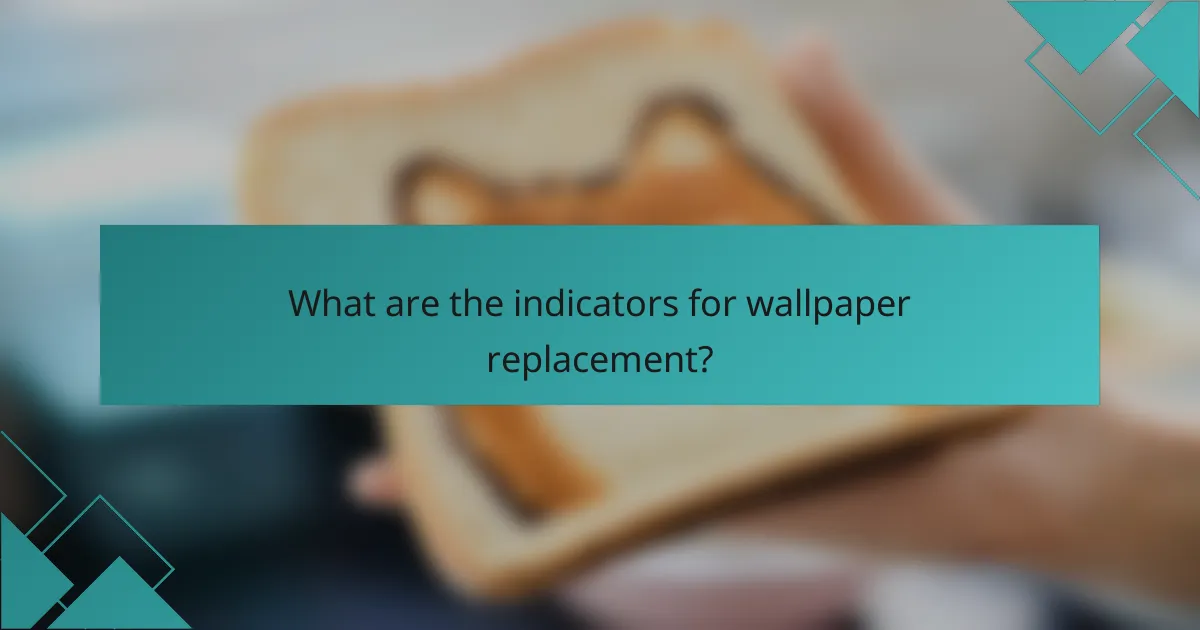
What are the indicators for wallpaper replacement?
Indicators for wallpaper replacement include visible damage, peeling, and fading. Recognizing these signs early can help maintain the aesthetic and integrity of your space.
Visible wear and tear signs
Visible wear and tear signs include scratches, dents, or stains that accumulate over time. These imperfections can detract from the overall appearance of a room. If the damage is extensive or concentrated in key areas, it may be time to consider a replacement.
Regular inspections can help identify these issues before they worsen. Look for areas that experience high traffic or exposure to moisture, as these are more prone to wear.
Peeling or bubbling wallpaper
Peeling or bubbling wallpaper is a clear indicator that the adhesive has failed or that moisture has infiltrated the wall. This can occur due to humidity, poor installation, or age. If you notice these issues, it’s essential to address them promptly to prevent further damage.
In some cases, you may be able to reattach the wallpaper with adhesive, but if the problem persists, replacing the wallpaper is often the best solution. Ensure that the wall surface is dry and clean before applying new wallpaper.
Fading colors and patterns
Fading colors and patterns can significantly impact the visual appeal of your wallpaper. Sunlight exposure, humidity, and the quality of the wallpaper material can all contribute to this fading. If your wallpaper looks dull or discolored, it may be time to replace it to restore the vibrancy of your space.
Consider using UV-resistant coatings or window treatments to protect new wallpaper from fading in the future. Regularly rotating furniture and decor can also help minimize direct sunlight exposure on your wallpaper.
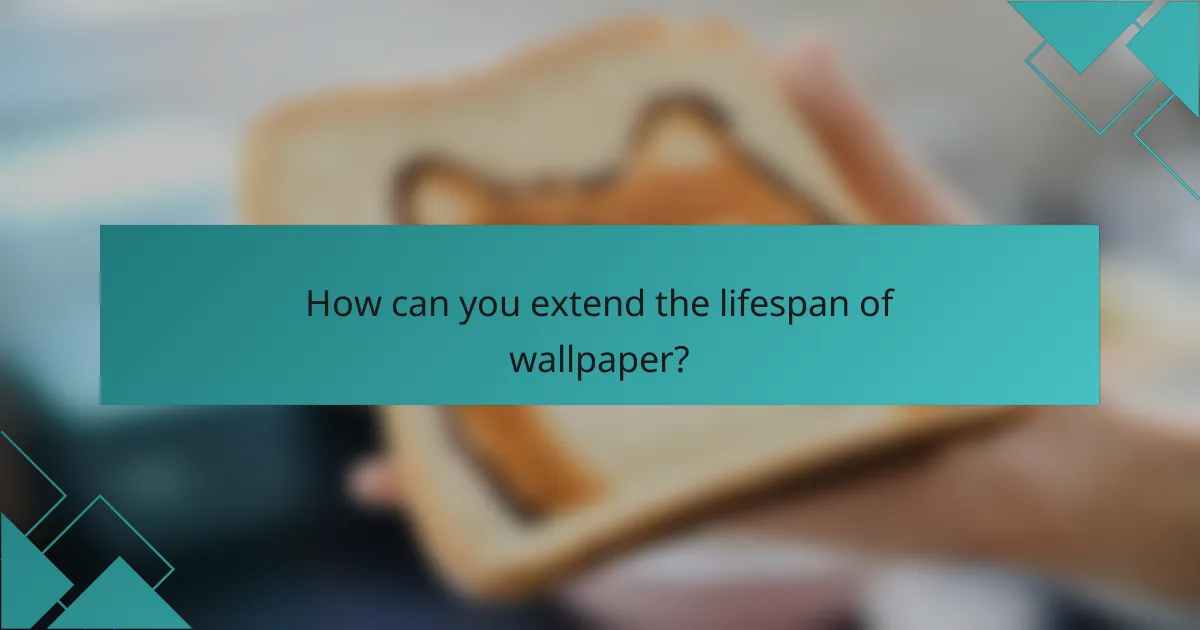
How can you extend the lifespan of wallpaper?
To extend the lifespan of wallpaper, regular maintenance and careful selection are essential. By implementing effective cleaning methods, controlling humidity, and choosing high-quality materials, you can significantly enhance the durability and appearance of your wallpaper.
Regular cleaning methods
Regular cleaning is vital for maintaining wallpaper. Use a soft cloth or a gentle vacuum attachment to remove dust and dirt without damaging the surface. For stains, a mild soap solution can be applied with a damp cloth, but always test on a small area first to ensure it does not affect the color or texture.
Avoid harsh chemicals or abrasive cleaners, as these can lead to discoloration or peeling. Establish a cleaning routine every few months to keep your wallpaper looking fresh and to prevent buildup that could lead to more significant damage.
Proper humidity control
Humidity control is crucial for wallpaper longevity. High humidity can cause wallpaper to peel or develop mold, while excessively dry conditions can lead to cracking. Aim for indoor humidity levels between 30% and 50% for optimal conditions.
Using a dehumidifier in damp areas or a humidifier in dry environments can help maintain these levels. Regularly check for signs of moisture issues, such as bubbling or discoloration, and address them promptly to prevent further damage.
Choosing high-quality materials
Selecting high-quality wallpaper materials is a key factor in extending lifespan. Look for wallpapers that are washable, scrubbable, or vinyl-coated, as these options offer better resistance to wear and tear. Investing in durable materials can save you from frequent replacements.
Additionally, consider the wallpaper’s backing and adhesive quality. A strong adhesive can prevent peeling, while a robust backing can enhance durability. Research brands and read reviews to ensure you choose products that are known for their longevity and performance.
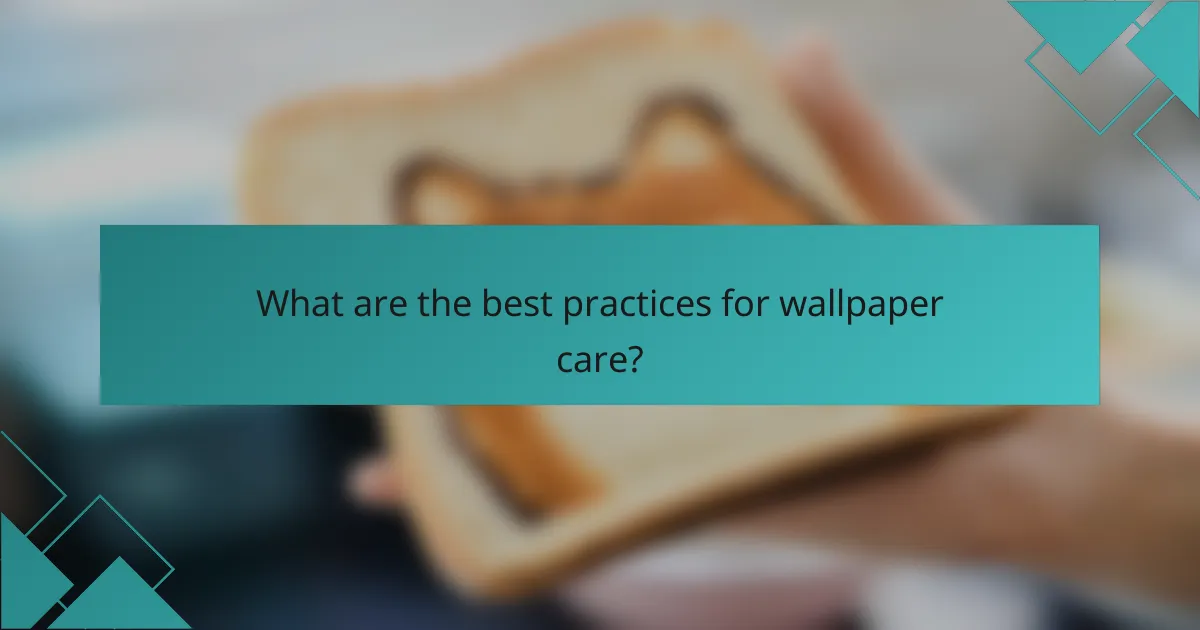
What are the best practices for wallpaper care?
To ensure the longevity of wallpaper, regular maintenance and proper cleaning techniques are essential. Following best practices helps prevent damage and keeps the wallpaper looking fresh and vibrant.
Recommended cleaning products
When cleaning wallpaper, it’s crucial to choose the right products to avoid damage. Mild soap solutions, such as dish soap mixed with water, are generally safe for most wallpapers. For vinyl or washable wallpapers, a gentle all-purpose cleaner can be effective.
Avoid harsh chemicals or abrasive cleaners, as they can strip the wallpaper’s finish or cause discoloration. Always test any cleaning solution on a small, inconspicuous area before applying it to the entire surface.
Maintenance tips for different wallpaper types
Different wallpaper types require specific care. For vinyl wallpaper, regular dusting with a soft cloth or vacuuming with a brush attachment is recommended. If stains occur, wipe them gently with a damp cloth and mild soap.
Fabric wallpapers need more delicate handling; avoid excessive moisture and use a dry cloth for dusting. For paper wallpapers, keep them dry and avoid direct sunlight to prevent fading. Consider using a protective spray designed for wallpaper to enhance durability.
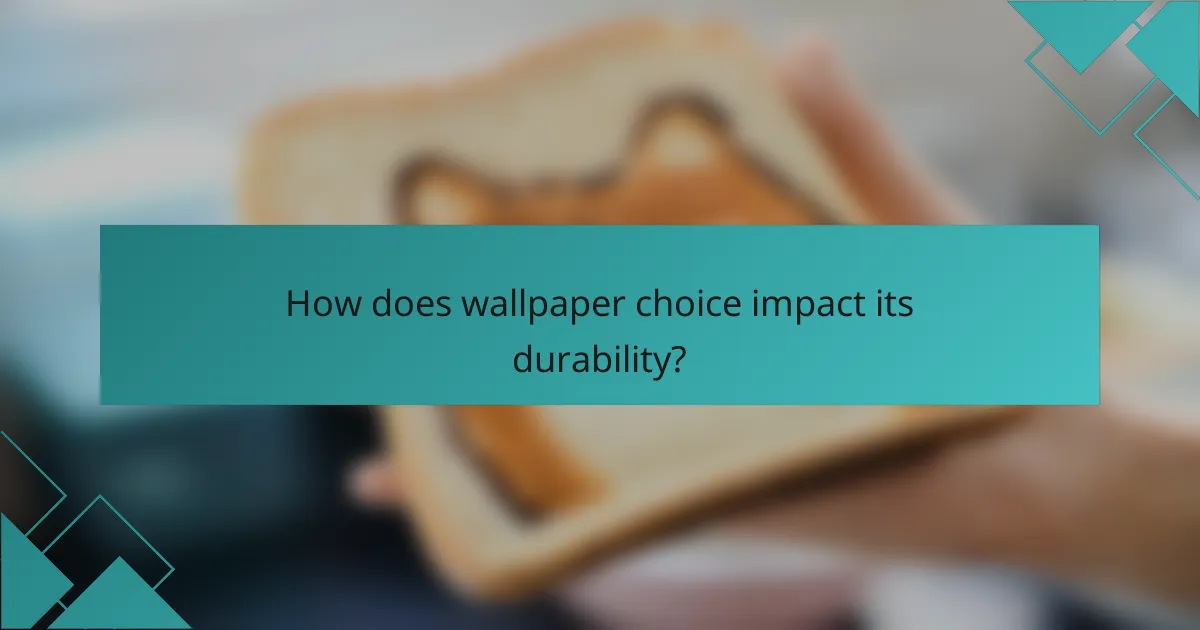
How does wallpaper choice impact its durability?
The choice of wallpaper significantly affects its durability and lifespan. Factors such as material, thickness, and finish can determine how well the wallpaper withstands wear and tear over time.
Comparing wallpaper materials
Different wallpaper materials offer varying levels of durability. Vinyl wallpaper, for instance, is known for its moisture resistance and is ideal for high-humidity areas like kitchens and bathrooms. Paper wallpaper, while often more affordable, tends to be less durable and may not hold up well in such environments.
Other materials, such as fabric or non-woven wallpaper, provide unique benefits. Fabric wallpaper can add texture and warmth but may require more maintenance. Non-woven options are easier to clean and remove, making them a practical choice for those who like to change their decor frequently.
Impact of design on wear
The design of wallpaper can influence its wear over time. Patterns that are bold and intricate may show signs of fading or damage more quickly than simpler designs, especially in high-traffic areas. Choosing a design that complements the room’s use can help maintain its appearance longer.
Additionally, finishes like gloss or matte can affect durability. Glossy finishes are generally easier to clean but may highlight imperfections, while matte finishes can be more forgiving but may attract dirt. Consider the room’s function and expected wear when selecting a design to ensure longevity.
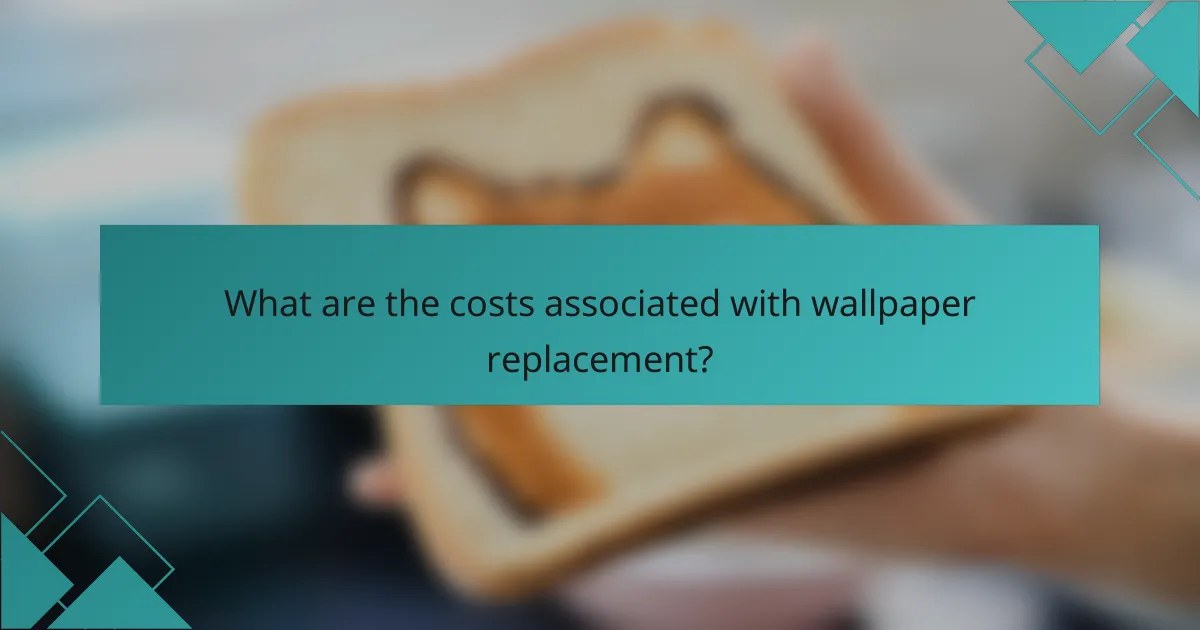
What are the costs associated with wallpaper replacement?
The costs of wallpaper replacement can vary significantly based on factors such as the type of wallpaper, the size of the area, and labor expenses. On average, homeowners might spend anywhere from a few hundred to several thousand dollars for materials and installation.
Material Costs
Material costs for wallpaper can range from low-cost vinyl options at around $10 to $50 per roll, to high-end designer papers that may exceed $200 per roll. Additionally, specialty wallpapers like grasscloth or silk can add to the overall expense. Consider the total square footage of the area to determine how many rolls you’ll need, as most rolls cover about 30 square feet.
Labor Costs
Labor costs for wallpaper installation typically range from $25 to $75 per hour, depending on the complexity of the job and the experience of the installer. Some professionals may charge a flat rate per room, which can be more economical for larger spaces. Always obtain multiple quotes to ensure competitive pricing.
Additional Expenses
In addition to material and labor costs, there may be extra expenses such as wall preparation, removal of old wallpaper, and necessary tools or adhesives. Wall preparation can add $1 to $3 per square foot, while removing old wallpaper may incur additional labor charges. Budgeting for these potential costs is essential to avoid surprises during the replacement process.
